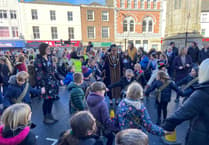WHEN I started to write a short nature column some 35 years ago, I lived in a house on the edge of Liskeard where I resided for more than 50 years, and wild birds that visited our garden were scarce except for the very unwelcome herring gulls that nested on roofs of neighbouring houses.
There was, however, one beautiful bird that only visited once to feed on the seeds of a tall teasel plant.
It was a lone Goldfinch. That was it really except for a few house sparrows.
Here in Quethiock, however, where we moved to 10 years ago, there is never a time when we can look out the windows and not be able to see at least a couple of birds, small or large, at any one time.
We have several feeders with sunflower seed hearts, fat balls and dried peanuts, and of course, plenty of water stations, and we often have a dozen or more Goldfinches commandeering the sunflower seed feeders.
Four members of the Tit family are regular visitors, with the Coal Tit being the smallest, having a black cap and bib with white cheeks.
They eat insects and seeds out in the wild so sunflower seeds are a bonus to their diet.
The Blue Tit is just a little larger but has the very familiar blue cap and yellow breast.
The Great Tit is larger still and has a black cap and white cheeks but with its yellow breast it looks like a large and colourful version of the Coal Tit.
The Long-tailed Tit is not really a true member of the Parus (Tit) family, but behaves like one and mixes with other tits, especially at the feeding stations.
Its tail, however, is as long again as its body, making it easily identifiable. Its main food is small insects.
The Starling is a very familiar and widespread bird and is about the same size and build as a thin blackbird.
Basically blackish with lighter speckles that makes it look rather dull, but when bright sunlight catches it at the right angle, the whole body lights up with an iridescent glow.
They visit our garden to eat berries from various bushes with their long, sharp, black beaks.
A small Pied Wagtail sometimes pays us a visit and seems content to hop and run around on the concrete path to pick up anything edible that has dropped off the feeders and any small insects.
A much larger black and white visitor is a Magpie that appears when dried bread or cake has been thrown out onto the lawn.
Again, in sunlight, like the starling, this bird glows with some beautiful petrol blue feathers on its wings and tail.
A tiny Wren regularly walks along the top of the fence in the garden with its short tail poking out whilst trying to look superior to a Goldcrest that sits on a nearby branch.
The Goldcrest is, of course, our smallest wild bird and I hope it turns up this coming weekend for the RSPB’s Big Garden Birdwatch.




